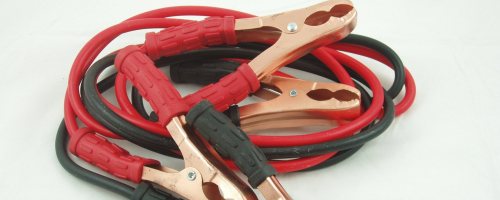
Anyone who drives a car will face a dead battery sooner or later. Whether you forgot to turn off the headlights, or the battery has just been stressed by cold whether, a dead battery is one of the most basic maintenance issues a car owner will face. The most common method of dealing with a dead car battery is to give the battery a "jump start". This method delivers an initial charge with jumper cables to get the car started, then the battery will be recharged by the alternator as the engine runs. The process of jump-starting a dead car battery is very simple as long as a few basic steps are adhered to.
Things You'll Need:
- Car with a charged battery
Step 1:
Position the car with the working battery near the car with a dead battery. Make sure that the running car is parked facing the car with the dead battery as much as possible or if the car batteries are off to one side of the engine, have those sides of the cars next to each other, since jumper cables have a limited length. Turn off the ignition of both vehicles and turn off all electronic devices, such as the radio, lights and air conditioner.
Step 2:
Connect one end of the positive jumper cable to the positive battery post on the car with the dead battery. The positive cable is identified by having red clamps. The positive battery terminal will be marked with "+," and usually has a red cable connected to it. Connect the other end of the positive battery cable to the positive terminal on the car with a good battery. To connect the cables, simply clip the clamp onto the terminal.
Step 3:
Connect one end of the negative jumper cable to an unpainted, clean metal surface under the hood of the car with the dead battery.
Step 4:
Start the car with the good battery. Rev the engine several times to help produce more electrical charge for the other car's battery. Start the car with the dead battery. You may have to try a couple of times before the engine turns over. If it won't turn over initially, give it a few more minutes to allow it a chance to charge some more.
Step 5:
Disconnect the jumper cables. Disconnect the cables in the reverse order that they were connected. Remove the black, negative cables first, then the red, positive cables.
Step 6:
Allow the car with the jumped battery to continue running for at least 30 minutes. As the car runs, the electric charge in the battery will be revitalized. Take the car for a brief drive on the highway to assist this process.
Tips:
Jumping a car battery is a last resort option. Try to properly charge or replace the battery in advance before a jump is required.
Warnings:
Do not allow the black and red clamps of the jumper cables to come into contact with each other if the other ends are connected to a battery.
Do not connect the negative cable to the negative post of the dead battery. This will minimize the risk of an explosion.
References:
Read More Like This
No comments:
Post a Comment